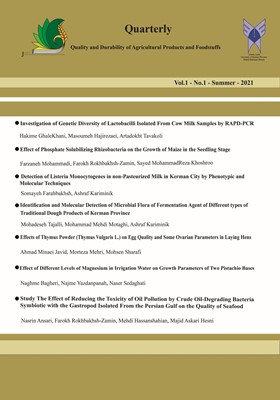شناسایی و تعیین هویت مولکولی فلور میکروبی عامل تخمیر دو نمونه خمیر نان های سنتی تولیدی در استان کرمان
الموضوعات : فصلنامه کیفیت و ماندگاری تولیدات کشاورزی و مواد غذاییمحدثه تجلی 1 , محمد مهدی متقی 2 , اشرف کریمی نیک 3
1 - دانشجوی کارشناسی ارشد، گروه میکروبیولوژی، واحد کرمان، دانشگاه آزاد اسلامی، کرمان، ایران
2 - استادیار، گروه میکروبیولوژی، واحد کرمان، دانشگاه آزاد اسلامی، کرمان، ایران
3 - استادیار، گروه میکروبیولوژی، واحد کرمان، دانشگاه آزاد اسلامی، کرمان، ایران
الکلمات المفتاحية: فلور میکروبی, sourdough, Molecular identification, هویت مولکولی, خمیر ترش, Microbial Flora,
ملخص المقالة :
فلور میکروبی خمیرترش عموماً حاوی مخمرها و باکتری های اسید لاکتیک بوده و اثر متقابل این میکروارگانیسم ها حائز اهمیت است. باکتری های اسید لاکتیک در طی تخمیر خمیرترش متابولیت های بی شماری را همچون اسیدهای آلی، آنزیم ها و اگزوپلی ساکاریدها را تولید می کنند که بر ساختار و خصوصیات رئولوژیکی خمیر و در نتیجه کیفیت بافت و بیاتی نان حاصل اثر مثبت دارند. هدف از تحقیق حاضر، شناسایی و مقایسه فلور میکروبی خمیر نان های سنتی شهرستان های مختلف استان کرمان به روش کشت و مولکولی بود. محیط کشت های ام آر اس و سابرودکستروزآگار به ترتیب جهت جداسازی باکتری های اسیدلاکتیک و مخمرها استفاده گردید. آزمون های بیوشیمیایی و ضد میکروبی انجام شد. 4 جدایه از باکتری ها و 4 جدایه از مخمرها به ترتیب با استفاده از روش مولکولی و مقایسه توالی های حاصل باتوالی های موجود در بانک ژن شناسایی گردید. گونه های باکتری عبارت بودند از ویسلاسیبریا، آسینتوباکتربائومانی، پدیوکوکوس پنتوزئوس و استافیلوکوکوس گالیناروم و مخمرها ساکارومایسس سرویزیه و کاندیدا تروپیکالیس بودند. بر اساس نتایج حاصله می توان میکرواورگانیسم های شناسایی شده در این تحقیق را جهت بالا بردن کیفیت نان و ایجاد طعم و آرومای بهتر نان پیشنهاد نمود.
1-Sakandar HA, Hussain R, Kubow S, Sadiq FA, Huang W, Imran M. Sour-dough bread: A contemporary cereal fermented product. Journal of Food Pro-cessing and Preservation. 2019;43(3): e13883. 2-Gänzle MG, Zheng J. Lifestyles of sourdough lactobacilli-Do they matter for microbial ecology and bread qua-lity?. International journal of food micr-obiology. 2019;302:15-23. 3-De Vuyst L, Van Kerrebroeck S, Harth H, Huys G, Daniel HM, Weckx S. Microbial ecology of sourdough ferme-ntations: diverse or uniform?. Food microbiology. 2014;37(1):11-29. 4-Plessas S. Innovations in Sourdough Bread Making. Fermentation. 2021; 7(1):29. 5-Lin XB, Gänzle MG. Quantitative high-resolution melting PCR analysis for monitoring of fermentation micro-biota in sourdough. International journal of food microbiology. 2014;186(1):8-42. 6-Bartkiene E, Lele V, Ruzauskas M, Domig KJ, Starkute V, Zavistanaviciute P, Bartkevics V, Pugajeva I, Klupsaite D, Juodeikiene G, Mickiene R. Lactic acid bacteria isolation from spontaneous sourdough and their characterization including antimicrobial and antifungal properties evaluation. Microorganisms. 2020;8(1):64. 7-Alfonzo A, Ventimiglia G, Corona O, Di Gerlando R, Gaglio R, Francesca N, Moschetti G, Settanni L. Diversity and technological potential of lactic acid bacteria of wheat flours. Food micro-biology. 2013;36(2):54-343. 8-Reddy G, Altaf MD, Naveena BJ, Venkateshwar M, Kumar EV. Amy-lolytic bacterial lactic acid fermen-tation-a review. Biotechnology advan-ces. 2008;26(1):22-34. 9-Saeedi V. Investigation of microbial biodiversity of three types of sourdo-ughs native to Isfahan region. 2011; Master Thesis. School of Agriculture. Isfahan University of Technology. 10-Tafti AG, Peighambardoust SH, Hejazi MA. Biochemical characterize-ation and technological properties of predominant Lactobacilli isolated from East-Azarbaijan sourdoughs (Iran). Inte-rnational Food Research Journal. 2013; 20(6):3293. 11-Vera A, Rigobello V, Demarigny Y. Comparative study of culture media used for sourdough lactobacilli. Food microbiology. 2009;26(7):33-728. 12-Venturi M, Guerrini S, Granchi L, Vincenzini M. Typing of Lactobacillus sanfranciscensis isolates from traditi-onal sourdoughs by combining conve-ntional and multiplex RAPD-PCR prof-iles. International journal of food micr-obiology. 2012;156(2):6-122. 13-Sterr Y, Weiss A, Schmidt H. Evalu-ation of lactic acid bacteria for sour-dough fermentation of amaranth. Inter-national journal of food microbiology. 2009;136(1):75-82. 14-Lattanzi A, Minervini F, Di Cagno R, Diviccaro A, Antonielli L, Cardinali G, Cappelle S, De Angelis M, Gobbetti M. The lactic acid bacteria and yeast microbiota of eighteen sourdoughs used for the manufacture of traditional Italian sweet leavened baked goods. Intern-ational Journal of Food Microbiology. 2013;163(2-3):9-71. 15-Nuobariene L, Cizeikiene D, Gradze-viciute E, Hansen ÅS, Rasmussen SK, Juodeikiene G, Vogensen FK. Phytase-active lactic acid bacteria from sourd-oughs: Isolation and identification. LWT-Food Science and Technology. 2015;63(1):72-766. 16-Lhomme E, Lattanzi A, Dousset X, Minervini F, De Angelis M, Lacaze G, Onno B, Gobbetti M. Lactic acid bacterium and yeast microbiotas of sixteen French traditional sourdoughs. International Journal of Food Micro-biology. 2015;215:70-161. 17-Nionelli L, Curri N, Curiel JA, Di Cagno R, Pontonio E, Cavoski I, Gobbetti M, Rizzello CG. Exploitation of Albanian wheat cultivars: characteri-zation of the flours and lactic acid bacteria microbiota, and selection of starters for sourdough fermentation. Food microbiology. 2014;44(1):96-107. 18-Rasool SMS, Nateghi L, Lavasani ASH, Estiri SH. Effect of Sourdough Containing Lactobacillus paracasei and fermentum on Physicochemical Proper-ties and Shelf life of Barbary Bread. Journal of Innovation in Food Science and Technology. 2019;11(2):1-4. 19-Valerio F, Bavaro AR, Di Biase M, Lonigro SL, Logrieco AF, Laverm-icocca P. Effect of amaranth and quinoa flours on exopolysaccharide production and protein profile of liquid sourdough fermented by Weissella cibaria and Lactobacillus plantarum. Frontiers in Microbiology. 2020;21(11):967.
_||_

